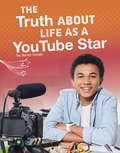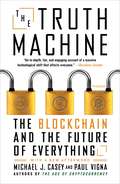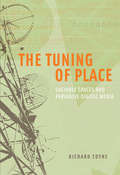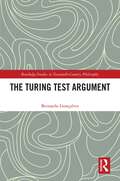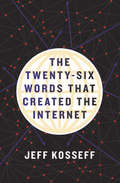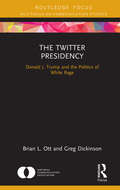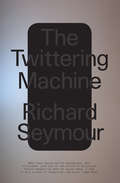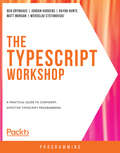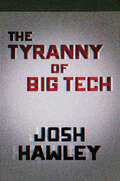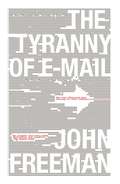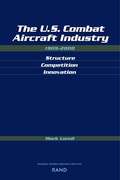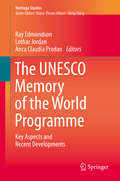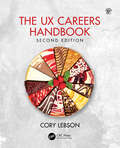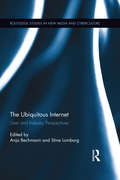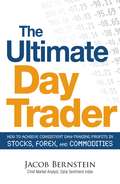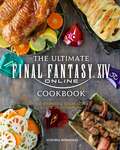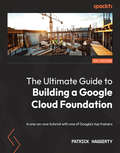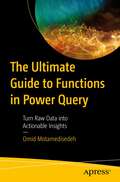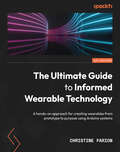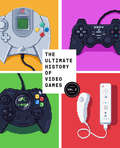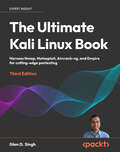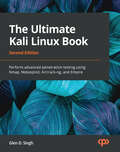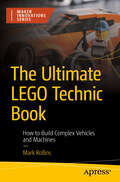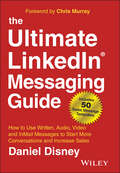- Table View
- List View
The Truth About Life as a YouTube Star (The Real Scoop)
by Sarah CordsHow does someone become a YouTube star? What do YouTube stars do? Learn about how YouTube stars make videos, talk to fans, and more!
The Truth Machine: The Blockchain and the Future of Everything
by Michael J. Casey Paul Vigna<p>Big banks have grown bigger and more entrenched. Privacy exists only until the next hack. Credit card fraud is a fact of life. Many of the “legacy systems” once designed to make our lives easier and our economy more efficient are no longer up to the task. Yet there is a way past all this—a new kind of operating system with the potential to revolutionize vast swaths of our economy: the blockchain. <p>In <i>The Truth Machine</i>, Michael J. Casey and Paul Vigna demystify the blockchain and explain why it can restore personal control over our data, assets, and identities; grant billions of excluded people access to the global economy; and shift the balance of power to revive society’s faith in itself. They reveal the disruption it promises for industries including finance, tech, legal, and shipping. <p>Casey and Vigna expose the challenge of replacing trusted (and not-so-trusted) institutions on which we’ve relied for centuries with a radical model that bypasses them. <i>The Truth Machine</i> reveals the empowerment possible when self-interested middlemen give way to the transparency of the blockchain, while highlighting the job losses, assertion of special interests, and threat to social cohesion that will accompany this shift. With the same balanced perspective they brought to <i>The Age of Cryptocurrency</i>, Casey and Vigna show why we all must care about the path that blockchain technology takes—moving humanity forward, not backward.
The Tuning of Place: Sociable Spaces and Pervasive Digital Media (The\mit Press Ser.)
by Richard CoyneHow pervasive digital devices—smartphones, iPods, GPS navigation systems, and their networks—us formulate a sense of place and refine social relationshipsHow do pervasive digital devices—smartphones, iPods, GPS navigation systems, and cameras, among others—influence the way we use spaces? In The Tuning of Place, Richard Coyne argues that these ubiquitous devices and the networks that support them become the means of making incremental adjustments within spaces—of tuning place. Pervasive media help us formulate a sense of place, writes Coyne, through their capacity to introduce small changes, in the same way that tuning a musical instrument invokes the subtle process of recalibration. Places are inhabited spaces, populated by people, their concerns, memories, stories, conversations, encounters, and artifacts. The tuning of place—whereby people use their devices in their interactions with one another—is also a tuning of social relations.The range of ubiquity is vast—from the familiar phones and hand-held devices through RFID tags, smart badges, dynamic signage, microprocessors in cars and kitchen appliances, wearable computing, and prosthetics, to devices still in development. Rather than catalog achievements and predictions, Coyne offers a theoretical framework for discussing pervasive media that can inform developers, designers, and users as they contemplate interventions into the environment. Processes of tuning can lead to consideration of themes highly relevant to pervasive computing: intervention, calibration, wedges, habits, rhythm, tags, taps, tactics, thresholds, aggregation, noise, and interference.
The Turing Test Argument (Routledge Studies in Twentieth-Century Philosophy)
by Bernardo GonçalvesThis book departs from existing accounts of Alan Turing's imitation game and test by placing Turing's proposal in its historical, social, and cultural context. It reconstructs a controversy in England, 1946–1952, over the intellectual capabilities of digital computers, which led Turing to propose his test. It argues that the Turing test is best understood not as a practical experiment, but as a thought experiment in the modern scientific tradition of Galileo Galilei. The logic of the Turing test argument is reconstructed from the rhetoric of Turing’s irony and wit. Turing believed that learning machines should be understood as a new kind of species, and their thinking as different from human thinking and yet capable of imitating it. He thought that the possibilities of the machines he envisioned were not utopian dreams. And yet he hoped that they would rival and surpass chauvinists and intellectuals who sacrifice independent thinking to maintain their power. These would be transformed into ordinary people, as work once considered 'intellectual' would be transformed into non-intellectual, 'mechanical' work. The Turing Test Argument will appeal to scholars and students in the sciences and humanities and all those interested in Turing's vision of the future of intelligent machines in society and nature.
The Twenty-Six Words That Created the Internet
by Jeff Kosseff"No provider or user of an interactive computer service shall be treated as the publisher or speaker of any information provided by another information content provider."Did you know that these twenty-six words are responsible for much of America's multibillion-dollar online industry? What we can and cannot write, say, and do online is based on just one law—a law that protects online services from lawsuits based on user content. Jeff Kosseff exposes the workings of Section 230 of the Communications Decency Act, which has lived mostly in the shadows since its enshrinement in 1996. Because many segments of American society now exist largely online, Kosseff argues that we need to understand and pay attention to what Section 230 really means and how it affects what we like, share, and comment upon every day.The Twenty-Six Words That Created the Internet tells the story of the institutions that flourished as a result of this powerful statute. It introduces us to those who created the law, those who advocated for it, and those involved in some of the most prominent cases decided under the law. Kosseff assesses the law that has facilitated freedom of online speech, trolling, and much more. His keen eye for the law, combined with his background as an award-winning journalist, demystifies a statute that affects all our lives –for good and for ill. While Section 230 may be imperfect and in need of refinement, Kosseff maintains that it is necessary to foster free speech and innovation. For filings from many of the cases discussed in the book and updates about Section 230, visit jeffkosseff.com
The Twitter Book (O'reilly Ser.)
by Tim O'Reilly Sarah MilsteinTwitter is not just for talking about your breakfast anymore. It's become an indispensable communications tool for businesses, non-profits, celebrities, and people around the globe. With the second edition of this friendly, full-color guide, you'll quickly get up to speed not only on standard features, but also on new options and nuanced uses that will help you tweet with confidence. Co-written by two widely recognized Twitter experts, The Twitter Book is packed with all-new real-world examples, solid advice, and clear explanations guaranteed to turn you into a power user. Use Twitter to connect with colleagues, customers, family, and friends Stand out on Twitter Avoid common gaffes and pitfalls Build a critical communications channel with Twitter--and use the best third-party tools to manage it. Want to learn how to use Twitter like a pro? Get the book that readers and critics alike rave about.
The Twitter Presidency: Donald J. Trump and the Politics of White Rage (NCA Focus on Communication Studies)
by Brian L. Ott Greg DickinsonThe Twitter Presidency explores the rhetorical style of President Donald J. Trump, attending to both his general manner of speaking as well as to his preferred modality. Trump’s manner, the authors argue, reflects an aesthetics of white rage, and it is rooted in authoritarianism, narcissism, and demagoguery. His preferred modality of speaking, namely through Twitter, effectively channels and transmits the affective dimensions of white rage by taking advantage of the platform’s defining characteristics, which include simplicity, impulsivity, and incivility. There is, then, a structural homology between Trump’s general communication practices and the specific platform (Twitter) he uses to communicate with his base. This commonality between communication practices and communication platform (manner and modality) struck a powerful emotive chord with his followers, who feel aggrieved at the decentering of white masculinity. In addition to charting the defining characteristics of Trump’s discourse, The Twitter Presidency exposes how Trump’s rhetorical style threatens democratic norms, principles, and institutions.
The Twittering Machine
by Richard SeymourA brilliant probe into the political and psychological effects of our changing relationship with social mediaFormer social media executives tell us that the system is an addiction-machine. We are users, waiting for our next hit as we like, comment and share. We write to the machine as individuals, but it responds by aggregating our fantasies, desires and frailties into data, and returning them to us as a commodity experience. The Twittering Machine is an unflinching view into the calamities of digital life: the circus of online trolling, flourishing alt-right subcultures, pervasive corporate surveillance, and the virtual data mines of Facebook and Google where we spend considerable portions of our free time. In this polemical tour de force, Richard Seymour shows how the digital world is changing the ways we speak, write, and think. Through journalism, psychoanalytic reflection and insights from users, developers, security experts and others, Seymour probes the human side of the machine, asking what we&’re getting out of it, and what we&’re getting into. Social media held out the promise that we could make our own history–to what extent did we choose the nightmare that it has become?
The TypeScript Workshop: A practical guide to confident, effective TypeScript programming
by Jordan Hudgens Ben Grynhaus Rayon Hunte Matt Morgan Wekoslav StefanovskiBroaden your skill set by learning TypeScript and applying your knowledge to build real-world applicationsKey FeaturesQuickly get started writing TypeScript code with hands-on exercises and activitiesDevelop new skills that can be applied at work or in your own side projectsBuild your understanding, boost your confidence, and advance your programming careerBook DescriptionBy learning TypeScript, you can start writing cleaner, more readable code that's easier to understand and less likely to contain bugs. What's not to like?It's certainly an appealing prospect, but learning a new language can be challenging, and it's not always easy to know where to begin. This book is the perfect place to start. It provides the ideal platform for JavaScript programmers to practice writing eloquent, productive TypeScript code.Unlike many theory-heavy books, The TypeScript Workshop balances clear explanations with opportunities for hands-on practice. You'll quickly be up and running building functional websites, without having to wade through pages and pages of history and dull, dry fluff. Guided exercises clearly demonstrate how key concepts are used in the real world, and each chapter is rounded off with an activity that challenges you to apply your new knowledge in the context of a realistic scenario.Whether you're a hobbyist eager to get cracking on your next project, or a professional developer looking to unlock your next promotion, pick up a copy and make a start! Whatever your motivation, by the end of this book, you'll have the confidence and understanding to make it happen with TypeScript.What you will learnConfigure a professional TypeScript development environmentExplore how to use primitive and complex data typesIncorporate types into popular npm (Node package manager) librariesDesign systems that use asynchronous behaviorImplement object-oriented programming to model real-world scenariosGet to grips with modern UI design by combining React with TypeScriptWho this book is forThe TypeScript Workshop is for software developers who want to broaden their skill set by learning the TypeScript programming language. To get the most from this TypeScript book, you should have basic knowledge of JavaScript or experience using another similar programming language.
The Tyranny of Big Tech
by Josh HawleyThe reign of Big Tech is here, and Americans’ First Amendment rights hang by a keystroke. Amassing unimaginable amounts of personal data, giants like Google, Facebook, Amazon, and Apple—once symbols of American ingenuity and freedom—have become a techno-oligarchy with overwhelming economic and political power. Decades of unchecked data collection have given Big Tech more targeted control over Americans’ daily lives than any company or government in the world. <P><P> In The Tyranny of Big Tech, Senator Josh Hawley of Missouri argues that these mega-corporations—controlled by the robber barons of the modern era—are the gravest threat to American liberty in decades. To reverse course, Hawley argues, we must correct progressives’ mistakes of the past. <P><P>That means recovering the link between liberty and democratic participation, building an economy that makes the working class strong, independent, and beholden to no one, and curbing the influence of corporate and political elites. <P><P>Big Tech and its allies do not deal gently with those who cross them, and Senator Hawley proudly bears his own battle scars. But hubris is dangerous. The time is ripe to overcome the tyranny of Big Tech by reshaping the business and legal landscape of the digital world. <P><P><b>A New York Times Bestseller</b>
The Tyranny of E-mail: The Four-thousand-year Journey to Your Inbox
by John Freeman"The computer and e-mail were sold to us as tools of liberation, but they have actually inhibited our ability to conduct our lives mindfully, with the deliberation and consideration that are the hallmark of true agency." The first e-mail was sent less than forty years ago; by 2011, there will be 3.2 billion e-mail users. The average corporate worker now receives upwards of two hundred e-mails per day. The flood of messages is ceaseless and follows us everywhere. We check e-mail in transit; we check it in the bath. We check it before bed and upon waking up. We check it even in midconversation, blithely assuming no one will notice. We no longer make our own to-do list. E-mail does. It's time for a break. In The Tyranny of E-mail, John Freeman takes an entertaining look at the nature of correspondence through the ages. From love poems delivered on clay tablets to the art of the letter to the first era of information overload (via the telegraph) to the vast network brought on by the Internet, Freeman answers the difficult question, Where is this taking us? Put down your BlackBerry and consider the consequences. As the toll of e-mail mounts by reducing our time for leisure and contemplation and by separating us from one another in an unending and lonely battle with the overfull inbox, John Freeman -- one of America's preeminent literary critics -- enters a plea for communication that is more selective and nuanced and, above all, more sociable.
The U.S. Combat Aircraft Industry, 1909-2000
by Mark A. LorellDrawing on primary and secondary sources on the aircraft industry, this report provides a brief survey of industry structure, innovation, and competition in the U.S. fixed-wing combat aircraft industry from its earliest days to the present. It supports a much larger research effort examining the future of the structure, innovation, and competition of the U.S. military aircraft industrial base that responds to congressional concerns about that future.
The UNESCO Memory of the World Programme: Key Aspects and Recent Developments (Heritage Studies)
by Ray Edmondson Lothar Jordan Anca Claudia ProdanThe volume “The UNESCO Memory of the World Programme: Key Aspects and Recent Developments” responds to the growing interest in the scientific study of the Memory of the World Programme (MoW) and its core concept of documentary heritage, which has received little attention from scholarship so far. This sixth publication in the Heritage Studies Series provides a first collection of differing approaches (including reflected reports, essays, research contributions, and theoretical reflections) for the study of the MoW Programme, offering a basis for follow-up activities. The volume, edited by Ray Edmondson, Lothar Jordan and Anca Claudia Prodan, brings together 21 scholars from around the globe to present aspects deemed crucial for understanding MoW, its development, relevance and potential. The aim is to encourage academic research on MoW and to enhance the understanding of its potential and place within Heritage Studies and beyond.
The UX Careers Handbook
by Cory LebsonThis second edition of The UX Careers Handbook offers you all the great advice of the first edition—freshly updated—plus a new chapter on critical soft skills, much more on becoming a UX leader, and a 17th user experience (UX) career pathway. The UX Careers Handbook, Second Edition, offers you an insider's advice on learning, personal branding, networking skills, building your resume and portfolio, and actually landing that UX job you want, as well as an in-depth look at what it takes to get into and succeed in a UX career. Whether your interests include design, information architecture, strategy, research, UX writing, or any of the other core UX skillsets, you'll find a wealth of resources in this book. The book also includes: Insights and personal stories from a range of industry-leading UX professionals to show you how they broke into the industry and evolved their own careers over time Activities and worksheets to help you make good decisions and build your career Along with the book, you can explore its companion website with more resources and information to help you stay on top of this fast-changing field. Not only for job seekers, The UX Careers Handbook, Second Edition, is a must-have for Employers and recruiters who want to better understand how to hire and keep UX staff Undergraduate and graduate students thinking about their future careers Professionals in other careers who are thinking about starting to do UX work Cory Lebson has been a UX consultant and user researcher for over two decades. He is Principal and Owner of a small UX research consultancy, a builder of UX community, and a past president of the User Experience Professionals Association (UXPA). Not only a practitioner of UX, Cory teaches and mentors to help professionals grow their UX skills and conducts regular talks and workshops on topics related to both UX skills and career development.
The Ubiquitous Internet: User and Industry Perspectives (Routledge Studies in New Media and Cyberculture)
by Anja Bechmann Stine LomborgThis book presents state of the art theoretical and empirical research on the ubiquitous internet: its everyday users and its economic stakeholders. The book offers a 360-degree media analysis of the contemporary terrain of the internet by examining both user and industry perspectives and their relation to one another. Contributors consider user practices in terms of internet at your fingertips—the abundance, free flow, and interconnectivity of data. They then consider industry’s use of user data and standards in commodification and value-creation.
The Ultimate Day Trader: How to Achieve Consistent Day Trading Profits in Stocks, Forex, and Commodities
by Jacob BernsteinDay trading is difficult. The path is fraught with risk. But a pot of gold awaits those who learn their lessons well. After four decades in the markets as a trader, analyst, author, educator, and system developer, Jacob Bernstein sets down a comprehensive guide to the art of day trading.You will learn:New day trading methodsOrder entry strategiesHow to avoid costly errors when using electronic trading platformsDetailed strategies to maximize profitsWith this book, readers will have the complete guide they need to profit from this risky but exciting field. Trading profits are just a day away.
The Ultimate Final Fantasy XIV Cookbook: The Essential Culinarian Guide to Hydaelyn (Gaming)
by Victoria RosenthalTravel through the exciting culinary world of FINAL FANTASY XIV.Journey through the rich culinary landscape of FINAL FANTASY XIV. Featuring favorite flavors from across Hydaelyn and Norvrandt and easy-to-follow instructions, this tome provides numerous tips on how to make the most of your ingredients. Start your day with Farmer&’s Breakfast, a very famous and simple-yet-delightful dish; savor the Knight&’s Bread of Coerthas; dive into La Noscea&’s Rolanberry Cheesecake, and many more. · Exclusive Foreword written by game director, Naoki Yoshida. · Perfect for cooks of every skill level. With step-by-step directions and beautiful photos, learn to make iconic in-game foods, bringing the lush culinary landscape of FINAL FANTASY XIV to life. · Over 70 Recipes for every occasion. From quick snacks you can enjoy while exploring Eorzea to decadent desserts and meals fit for royalty, this book contains recipes for both simple and celebratory fare. · Inspiring Photography. Gorgeous photos of finished recipes help ensure success! · A stunning addition to your collection. This exquisitely detailed hardcover book is the perfect acquisition for your kitchen library—a must have for every FINAL FANTASY fan.
The Ultimate Guide to Building a Google Cloud Foundation: A one-on-one tutorial with one of Google's top trainers
by Patrick HaggertyFollow Google's own ten-step plan to construct a secure, reliable, and extensible foundation for all your Google Cloud base infrastructural needsKey FeaturesBuild your foundation in Google Cloud with this clearly laid out, step-by-step guideGet expert advice from one of Google's top trainersLearn to build flexibility and security into your Google Cloud presence from the ground upBook DescriptionFrom data ingestion and storage, through data processing and data analytics, to application hosting and even machine learning, whatever your IT infrastructural need, there's a good chance that Google Cloud has a service that can help. But instant, self-serve access to a virtually limitless pool of IT resources has its drawbacks. More and more organizations are running into cost overruns, security problems, and simple "why is this not working?" headaches. This book has been written by one of Google's top trainers as a tutorial on how to create your infrastructural foundation in Google Cloud the right way. By following Google's ten-step checklist and Google's security blueprint, you will learn how to set up your initial identity provider and create an organization. Further on, you will configure your users and groups, enable administrative access, and set up billing. Next, you will create a resource hierarchy, configure and control access, and enable a cloud network. Later chapters will guide you through configuring monitoring and logging, adding additional security measures, and enabling a support plan with Google. By the end of this book, you will have an understanding of what it takes to leverage Terraform for properly building a Google Cloud foundational layer that engenders security, flexibility, and extensibility from the ground up.What you will learnCreate an organizational resource hierarchy in Google CloudConfigure user access, permissions, and key Google Cloud Platform (GCP) security groupsConstruct well thought out, scalable, and secure virtual networksStay informed about the latest logging and monitoring best practicesLeverage Terraform infrastructure as code automation to eliminate toilLimit access with IAM policy bindings and organizational policiesImplement Google's secure foundation blueprintWho this book is forThis book is for anyone looking to implement a secure foundational layer in Google Cloud, including cloud engineers, DevOps engineers, cloud security practitioners, developers, infrastructural management personnel, and other technical leads. A basic understanding of what the cloud is and how it works, as well as a strong desire to build out Google Cloud infrastructure the right way will help you make the most of this book. Knowledge of working in the terminal window from the command line will be beneficial.
The Ultimate Guide to Functions in Power Query: Turn Raw Data into Actionable Insights
by Omid MotamedisedehThis book is a complete guide to using functions in Power Query and is designed to help users of all skill levels learn and master its various functions. The Ultimate Guide to Functions in Power Query begins with an introduction to Power Query and an overview of the different types of functions available, along with detailed explanations of how to use each of them. You’ll see how to leverage power functions to process and transform large datasets from various sources and learn advanced techniques such as creating custom functions and using conditional statements. The book also covers best practices for using functions, including tips on how to optimize query performance and troubleshoot common errors. Using practical example applications, Author Omid Motamedisedeh demonstrates how to optimize your data processing workflows, saving time and boosting productivity. By the end of the book, readers will have a deep understanding of Power Query functions and be able to apply their knowledge to a wide range of data analysis tasks. What You Will Learn Master the fundamentals of Power Query, including how to load and transform data from various sourcesUnderstand all the functions available in Power Query, including text, date/time, logical, numeric, and moreUse functions to transform data and perform complex calculationsEmploy advanced techniques such as custom functions, conditional statements, and working with parametersOptimize query performance, handle errors, and use the M language effectivelyUse real-world examples and exercises to hone your skills and gain practical experience with the tool Who This Book Is For Anyone who wants to learn how to use functions in Power Query to transform and analyze data. This includes data analysts, business analysts, Excel users, and data scientists. Readers should have a basic understanding of Excel and data analysis concepts, but may be new to Power Query and functions.
The Ultimate Guide to Informed Wearable Technology: A hands-on approach for creating wearables from prototype to purpose using Arduino systems
by Christine FarionMaster wearable technology with this book including colored images and over 50 activities using Arduino and ESP32, build useful, stylish, and smart wearable devices, and create interactive circuits that react to us and our environmentKey FeaturesLearn wearable technology and build electronic circuits with fun activities using Arduino systemsGet an in-depth understanding of e-textiles and ESP32 microcontrollers to create interactive wearablesApply a design innovation approach and best practices to address real-world issuesBook DescriptionWearable circuits add interaction and purpose to clothing and other wearable devices that are currently widely used in medical, social, safety, entertainment, and sports fields. To develop useful and impressive prototypes and wearables, you'll need to be skilled in designing electronic circuits and working with wearable technologies.This book takes you on an interesting journey through wearable technology, starting from electronic circuits, materials, and e-textile toolkits to using Arduino, which includes a variety of sensors, outputs, actuators, and microcontrollers such as Gemma M0 and ESP32. As you progress, you'll be carefully guided through creating an advanced IoT project. You'll learn by doing and create wearables with the help of practical examples and exercises. Later chapters will show you how to develop a hyper-body wearable and solder and sew circuits. Finally, you'll discover how to build a culture-driven wearable to track data and provide feedback using a Design Innovation approach.After reading this book, you'll be able to design interactive prototypes and sew, solder, and program your own Arduino-based wearable devices with a purpose.What you will learnConstruct sewable electronic circuits with conductive thread and materialsDiscover the features of LilyPad, Gemma, Circuit Playground, and other boardsUse various components for listening, moving, sensing actions, and visualizing outputsControl ESP32 development boards for IoT explorationUnderstand why and how to prototype to create interactive wearablesGet skilled in sewing and soldering sensors to Arduino-based circuitsDesign and build a hyper-body wearable that senses and reactsMaster a Design Innovation approach for creating wearables with a purposeWho this book is forThis book is for electronics engineers, embedded system engineers and designers, and R&D engineers, who are beginners in the wearable technology domain as well as makers and hobbyists who have an interest in creative computing. It will also be useful for teachers, students, and researchers, who are learning interaction design, physical computing, technology, fashion, or arts. Having a basic understanding of Arduino-based systems will help in easily comprehending the contents of the book.
The Ultimate History of Video Games, Volume 2: Nintendo, Sony, Microsoft, and the Billion-Dollar Battle to Shape Modern Gaming (Ultimate History of Video Games #2)
by Steven L. KentThe definitive behind-the-scenes history of video games&’ explosion into the twenty-first century and the war for industry power&“A zippy read through a truly deep research job. You won&’t want to put this one down.&”—Eddie Adlum, publisher, RePlay MagazineAs video games evolve, only the fittest companies survive. Making a blockbuster once cost millions of dollars; now it can cost hundreds of millions, but with a $160 billion market worldwide, the biggest players are willing to bet the bank.Steven L. Kent has been playing video games since Pong and writing about the industry since the Nintendo Entertainment System. In volume 1 of The Ultimate History of Video Games, he chronicled the industry&’s first thirty years. In volume 2, he narrates gaming&’s entrance into the twenty-first century, as Nintendo, Sega, Sony, and Microsoft battle to capture the global market.The home console boom of the &’90s turned hobby companies like Nintendo and Sega into Hollywood-studio-sized business titans. But by the end of the decade, they would face new, more powerful competitors. In boardrooms on both sides of the Pacific, engineers and executives began, with enormous budgets and total secrecy, to plan the next evolution of home consoles. The PlayStation 2, Nintendo GameCube, and Sega Dreamcast all made radically different bets on what gamers would want. And then, to the shock of the world, Bill Gates announced the development of the one console to beat them all—even if Microsoft had to burn a few billion dollars to do it. In this book, you will learn about• the cutthroat environment at Microsoft as rival teams created console systems• the day the head of Sega of America told the creator of Sonic the Hedgehog to &“f**k off&”• how &“lateral thinking with withered technology&” put Nintendo back on top• and much more!Gripping and comprehensive, The Ultimate History of Video Games: Volume 2 explores the origins of modern consoles and of the franchises—from Grand Theft Auto and Halo to Call of Duty and Guitar Hero—that would define gaming in the new millennium.
The Ultimate Kali Linux Book: Harness Nmap, Metasploit, Aircrack-ng, and Empire for cutting-edge pentesting
by Glen D. SinghExcel in penetration testing by delving into the latest ethical hacking tools and techniques from scratch Purchase of the print or Kindle book includes a free eBook in PDF format.Key FeaturesLearn to think like an adversary to strengthen your cyber defencesExecute sophisticated real-life penetration tests, uncovering vulnerabilities in enterprise networks that go beyond the surface levelSecurely manipulate environments using Kali Linux, ensuring you're fully equipped to safeguard your systems against real-world threatsBook DescriptionEmbark on an exciting journey into the world of Kali Linux – the central hub for advanced penetration testing. Honing your pentesting skills and exploiting vulnerabilities or conducting advanced penetration tests on wired and wireless enterprise networks, Kali Linux empowers cybersecurity professionals. In its latest third edition, this book goes further to guide you on how to setup your labs and explains breaches using enterprise networks. This book is designed for newcomers and those curious about penetration testing, this guide is your fast track to learning pentesting with Kali Linux 2024.x. Think of this book as your stepping stone into real-world situations that guides you through lab setups and core penetration testing concepts. As you progress in the book you’ll explore the toolkit of vulnerability assessment tools in Kali Linux, where gathering information takes the spotlight. You'll learn how to find target systems, uncover device security issues, exploit network weaknesses, control operations, and even test web applications. The journey ends with understanding complex web application testing techniques, along with industry best practices. As you finish this captivating exploration of the Kali Linux book, you'll be ready to tackle advanced enterprise network testing – with newfound skills and confidence.What you will learnEstablish a firm foundation in ethical hackingInstall and configure Kali Linux 2024.1Build a penetration testing lab environment and perform vulnerability assessmentsUnderstand the various approaches a penetration tester can undertake for an assessmentGathering information from Open Source Intelligence (OSINT) data sourcesUse Nmap to discover security weakness on a target system on a networkImplement advanced wireless pentesting techniquesBecome well-versed with exploiting vulnerable web applicationsWho this book is forThis pentesting book is for students, trainers, cybersecurity professionals, cyber enthusiasts, network security professionals, ethical hackers, penetration testers, and security engineers. If you do not have any prior knowledge and are looking to become an expert in penetration testing using the Kali Linux, then this book is for you.
The Ultimate Kali Linux Book: Perform advanced penetration testing using Nmap, Metasploit, Aircrack-ng, and Empire, 2nd Edition
by Glen D. SinghExplore the latest ethical hacking tools and techniques to perform penetration testing from scratchPurchase of the print or Kindle book includes a free eBook in the PDF formatKey FeaturesLearn to compromise enterprise networks with Kali LinuxGain comprehensive insights into security concepts using advanced real-life hacker techniquesUse Kali Linux in the same way ethical hackers and penetration testers do to gain control of your environmentBook DescriptionKali Linux is the most popular and advanced penetration testing Linux distribution within the cybersecurity industry. Using Kali Linux, a cybersecurity professional will be able to discover and exploit various vulnerabilities and perform advanced penetration testing on both enterprise wired and wireless networks. This book is a comprehensive guide for those who are new to Kali Linux and penetration testing that will have you up to speed in no time. Using real-world scenarios, you'll understand how to set up a lab and explore core penetration testing concepts. Throughout this book, you'll focus on information gathering and even discover different vulnerability assessment tools bundled in Kali Linux. You'll learn to discover target systems on a network, identify security flaws on devices, exploit security weaknesses and gain access to networks, set up Command and Control (C2) operations, and perform web application penetration testing. In this updated second edition, you'll be able to compromise Active Directory and exploit enterprise networks. Finally, this book covers best practices for performing complex web penetration testing techniques in a highly secured environment. By the end of this Kali Linux book, you'll have gained the skills to perform advanced penetration testing on enterprise networks using Kali Linux.What you will learnExplore the fundamentals of ethical hackingUnderstand how to install and configure Kali LinuxPerform asset and network discovery techniquesFocus on how to perform vulnerability assessmentsExploit the trust in Active Directory domain servicesPerform advanced exploitation with Command and Control (C2) techniquesImplement advanced wireless hacking techniquesBecome well-versed with exploiting vulnerable web applicationsWho this book is forThis pentesting book is for students, trainers, cybersecurity professionals, cyber enthusiasts, network security professionals, ethical hackers, penetration testers, and security engineers. If you do not have any prior knowledge and are looking to become an expert in penetration testing using the Kali Linux operating system (OS), then this book is for you.
The Ultimate LEGO Technic Book: How to Build Complex Vehicles and Machines (Maker Innovations Series)
by Mark RollinsLEGO has come a long way from the days of simple square bricks, and many still associate LEGO with their various playsets. For those that want more advanced building, some LEGO enthusiasts prefer the Technic sets, which feature beams, axles, gears, and other mechanized parts that can be powered and programmed to make fairly complex machines. This book begins with an introduction of basic pieces and building techniques, and there will be instruction of how to build some terrific vehicles that will look like actual cars, planes, and other machines. Not only that, I will instruct how to make these vehicles do all kinds of motion, even steering and walking! After reading this book, the reader will be inspired to create any machine they want. They will also be able to use the programming tools for even more mechanical creations in the future. What You'll Learn How to use beams, axles, gears, and other mechanized parts to create intricate and functional machines. How to create building impressive vehicles with step-by-step instructions. How to innovate and design your unique LEGO creations Learn the basics of Technic to bring creations to life Who This Book Is For This is a book that is made for students but is also made for educators. From the classroom to the adult hobbyist, people from all over the world want to create, thanks to Maker culture. This book will help those who are not certain where to begin with their creations.
The Ultimate LinkedIn Messaging Guide: How to Use Written, Audio, Video and InMail Messages to Start More Conversations and Increase Sales
by Daniel DisneyGet people to read, listen to, and watch your LinkedIn messages The Ultimate LinkedIn Messaging Guide is for salespeople, businesses, recruiters, and LinkedIn users who struggle to get replies and results on the essential business platform. In this book, author Daniel Disney shows you just how powerful LinkedIn can be when you figure out how to do it right. You’ll discover how to use LinkedIn messages to get noticed by employers, get attention to your business, and close deals. When you master LinkedIn messaging with the proven tips inside this book, you’ll be able to start more conversations, create more opportunities and drive more sales and revenue. What you’re looking for is out there – if you know how to reach the people who can help. But in this age of information overload, no one will respond to a spammy message, call, or e-mail. You need to stand out and prove that you’re legitimate. In this book, you’ll find real examples of successful messages, as well as over 50 message templates and scripts for written, audio, video and InMail messages. There are also QR codes throughout the book that take you to recorded examples of video and audio messages so you can see and hear them in action. Learn how to send personalised connection requests and LinkedIn messages that prompt people to talk to you Discover tips for building your network and reaching the decision makers at any company Leverage the power of audio and video messages to connect more effectively on LinkedIn Follow up and convert replies into sales, job offers, and high-value relationshipsIf you’ve struggled to get noticed, meet the right people, and close deals, The Ultimate LinkedIn Messaging Guide is the tool you need to turn it around.
